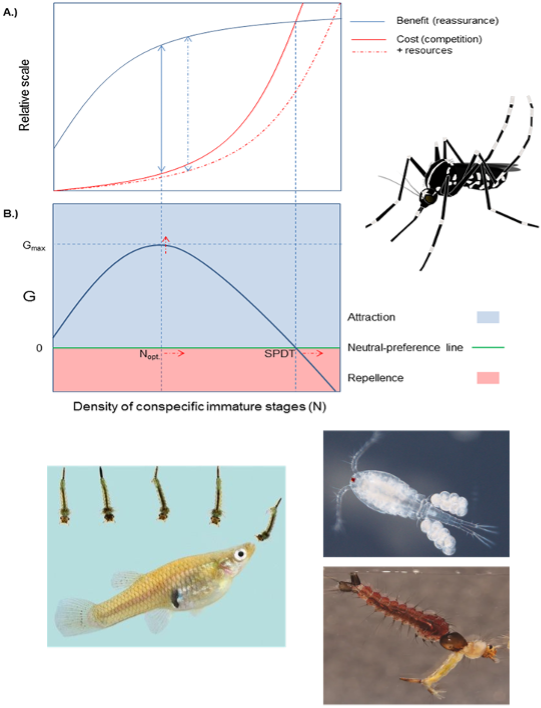 For organisms lacking parental care and where larval dispersal is limited, oviposition site selection decisions are critical fitness-enhancing choices. The oviposition behavior of such insect vectors is a critical driver of their distribution and abundance. Therefore, improved understanding of this behavior is essential for our ability to control them. This is particularly important for the control of container breeding mosquitoes to which traditional broadcast spraying is typically not effective. It is, therefore, important to understand the response of gravid container-breeding mosquitoes to competitors, predators, and food resource level.
For organisms lacking parental care and where larval dispersal is limited, oviposition site selection decisions are critical fitness-enhancing choices. The oviposition behavior of such insect vectors is a critical driver of their distribution and abundance. Therefore, improved understanding of this behavior is essential for our ability to control them. This is particularly important for the control of container breeding mosquitoes to which traditional broadcast spraying is typically not effective. It is, therefore, important to understand the response of gravid container-breeding mosquitoes to competitors, predators, and food resource level.
The presence of conspecific immature stages in a potential oviposition site could, on the one hand, indicate the suitability of that site but on the other hand could indicate the potential for intraspecific competition. In this paper, we present a graphic model suggesting that the trade-off between these two opposing forces could result in a hump-shaped density-dependent relationship between oviposition rate and conspecific immature stage density (hereafter, the “Hump-shaped regulation model”) with positive effects of aggregation prevailing at low densities and negative effect of intraspecific competition prevailing at higher densities. We field-tested the predictions of this model at both the egg- and the larval levels with Aedes albopictus and evaluated if and how these relationships are affected by resource enrichment.
In this study, we evaluated the effect of food level on the oviposition behavior of Aedes albopictus in the presence or the absence of a nonlethal predator (caged dragonfly nymph). We also attempted to quantify the perceived cost of predation to ovipositioning mosquitoes. Mosquitoes were presented with oviposition cups containing four levels of larval food (fermented leaf infusion) with or without a caged libellulid nymph. By titrating larval food, we estimated the amount of food needed to attract the female mosquito to oviposit in the riskier habitat. As expected, oviposition rate increased with food level and decreased in the presence of a predator. However, the effect of food level did not differ between predator treatments. By calculating the difference in the amount of food for points of equal oviposition rate in the predator-present and predator-absent regression lines, we estimated the cost of predation risk to be 1950 colony-forming units per milliliter. In additional studies we showed that Gambusia fish has a significant deterrent effect on egg deposition but copepods and Toxorhynchites rutilus (predatory mosquito larvae) had no effect.